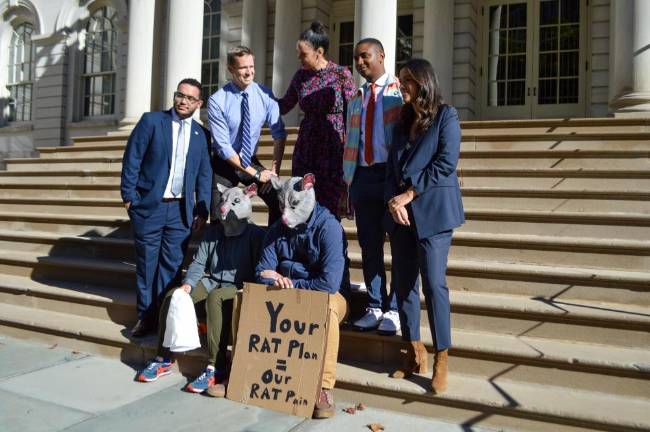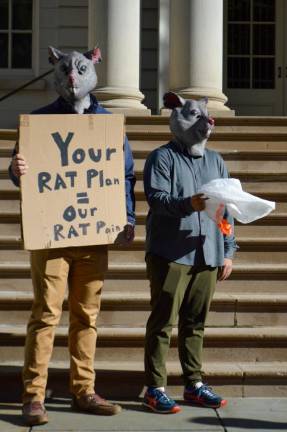City Council’s ‘Rat Pack’ Says Rodents Are Ready to ‘Surrender’
New legislation passed on Thursday will evict rats from large construction projects, create “rat mitigation zones” and crack down on feeding frenzies


In a city of millions, there’s an alarming number of unwelcome guests — ones that scurry, lurk and leap. Everyone’s seen them: rats.
“We are experiencing an epidemic of rats in New York City,” Manhattan Borough President Mark Levine told Our Town in mid-October. “We are getting inundated with reports.” In the month of October alone, as of Thursday, over 2,650 rat and mouse-related complaints had been called into 311, city data showed. Already this year, cumulative sightings by the end of July had reached a decade-high of 16,000, compared to 2,000 a year prior, Fox5 reported.
But that number may soon begin to level off, in part thanks to a package of anti-rat bills passed by the City Council on Thursday. Two of the new bills, brought forward by Council Members Shaun Abreu and Chi Ossé call on the Department of Health and Mental Hygiene (DOHMH) to create “rat mitigation zones” by April of next year and require that the agency then “issue an annual report on the success of rat mitigation measures” in those areas.
Another mandates that buildings store their trash in “rodent-proof containers” for a minimum of two years, if they’ve racked up two or more rodent-related housing maintenance or health code violations.
A fourth and final bill sponsored by Chelsea Council Member Erik Bottcher requires that construction project applicants provide proof of hiring an exterminator to expel rats prior to receiving a work permit if 50% or more of the building’s floor area will be under construction or over 50% is to be demolished; if the floor area of a building will be increased by more than 25% of the existing area; or if complete demolition is sought.
“For good actors, which is, thankfully, the majority of builders, this will just codify what they’re already doing. Good actors are developing a rat mitigation plan and are carrying it out,” Levine said of the bill. “But there are too many builders who are cutting corners on this.”
A Long Time Coming
Levine originally sponsored the construction-related legislation during the City Council’s last session, when he represented a northern stretch of the Upper West Side through Washington Heights. This time around, he partnered with Bottcher.
“People are not going to want to live here — they’re not going to want to work here or visit here — if they’re seeing rats all the time,” Bottcher said during a Thursday morning press conference on the steps of City Hall. It’s his first bill to pass the City Council, since taking office at the start of this year.
That morning, City Council members directed some of their comments toward two people dressed as rat protesters, who stood cooperatively beside them. “Rats may be our neighbors, but they are not our friends,” said Abreu, who represents Levine’s former district.
The rodent problem may have been exacerbated by the pandemic. But a boom in construction, “a good thing, no doubt,” Levine said, has likely also played a role.
“When you’re renovating an older building or digging out a foundation for a newer building, you can often kick up, basically, rat burrows that then send the rats out into the neighborhood,” Levine explained. “And it’s really a hardship for the surrounding community.”
When the new bill from Bottcher goes into effect in six months, “improvements will be felt,” Levine said — especially by those who live near ongoing or forthcoming construction projects. But Council Member Sandy Nurse, chair of the Committee on Sanitation and Solid Waste Management, emphasized on Thursday that to really quell the city’s rodent problem, “universal” curbside composting and a “citywide containerization program” are needed.
“A Bonanza Of Food For Rats”
In-progress plans to make outdoor dining last in the city are also incorporating a focus on rat mitigation. Dining structures on the streets will have to be removable, according to Levine, so that rats can’t live rent-free — or permanently — underneath.
Something more obvious, however, might be most to blame: trash. Rather than leaving bags on the street for collection each week, a new Department of Sanitation (DSNY) pilot is testing the use of “rodent-resistant containers” in which garbage can be stored away — because the current method of piling trash bags upon trash bags isn’t quite cutting it. In mid-October, Mayor Eric Adams announced a new plan to push back the hour at which trash can be left out on the street for collection, from 4 p.m. to 8 p.m., beginning in April of next year. “The rats don’t run the city; we do,” DSNY Commissioner Jessica Tisch said at the press conference.
“If not done properly,” Levine told Our Town of trash removal for pickup, it “can become a bonanza of food for rats.” A real New York City nightmare. But City Council members have other plans — and some relieving news.
“The rats have told us they want to formally surrender,” Nurse said on Thursday as the two rat protesters walked by, waving a white trash bag in defeat.
“Rats may be our neighbors, but they are not our friends.” Council Member Shaun Abreu